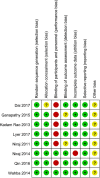The analgesic efficacy compared ultrasound-guided continuous transverse abdominis plane block with epidural analgesia following abdominal surgery: a systematic review and meta-analysis of randomized controlled trials
- PMID: 32111162
- PMCID: PMC7048149
- DOI: 10.1186/s12871-020-00969-0
The analgesic efficacy compared ultrasound-guided continuous transverse abdominis plane block with epidural analgesia following abdominal surgery: a systematic review and meta-analysis of randomized controlled trials
Abstract
Background: This review and meta-analysis aims to evaluate the analgesic efficacy of continuous transversus abdominis plane (TAP) block compared with epidural analgesia (EA) in adults after abdominal surgery.
Methods: The databases PubMed, Embase and Cochrane Central Register were searched from inception to June 2019 for all available randomized controlled trials (RCTs) that evaluated the analgesic efficacy of continuous TAP block compared with EA after abdominal surgery. The weighted mean differences (WMDs) were estimates for continuous variables with a 95% confidence interval (CI) and risk ratio (RR) for dichotomous data. The pre-specified primary outcome was the dynamic pain scores 24 h postoperatively.
Results: Eight trials including 453 patients (TAP block:224 patients; EA: 229 patients) ultimately met the inclusion criteria and seven trials were included in the meta-analysis. Dynamic pain scores after 24 h were equivalent between TAP block and EA groups (WMD:0.44; 95% CI: 0.1 to 0.99; I2 = 91%; p = 0.11). The analysis showed a significant difference between the subgroups according to regularly administering (4 trials; WMD:-0.11; 95% CI: - 0.32 to 0.09; I2 = 0%; p = 0.28) non-steroidal anti-inflammatory drugs (NSAIDs) or not (3 trials; WMD:1.02; 95% CI: 0.09 to 1.96; I2 = 94%; p = 0.03) for adjuvant analgesics postoperatively. The measured time of the urinary catheter removal in the TAP group was significantly shorter (3 trials, WMD:-18.95, 95% CI:-25.22 to - 12.71; I2 = 0%; p < 0.01), as was time to first ambulation postoperatively (4 trials, WMD:-6.61, 95% CI: - 13.03 to - 0.19; I2 = 67%; p < 0.05).
Conclusion: Continuous TAP block, combined with NSAIDs, can provide non-inferior dynamic analgesia efficacy compared with EA in postoperative pain management after abdominal surgery. In addition, continuous TAP block is associated with fewer postoperative side effects.
Keywords: Abdominal surgery; Epidural analgesia; Meta-analysis; TAP block.
Conflict of interest statement
The authors declare that they have no competing interests.
Figures






Similar articles
-
The Analgesic Efficacy of Ultrasound-Guided Transversus Abdominis Plane Block in Adult Patients: A Meta-Analysis.Anesth Analg. 2015 Dec;121(6):1640-54. doi: 10.1213/ANE.0000000000000967. Anesth Analg. 2015. PMID: 26397443
-
Quadratus lumborum block versus transversus abdominis plane block for postoperative analgesia in patients undergoing abdominal surgeries: a systematic review and meta-analysis of randomized controlled trials.BMC Anesthesiol. 2020 Mar 2;20(1):53. doi: 10.1186/s12871-020-00967-2. BMC Anesthesiol. 2020. PMID: 32122319 Free PMC article.
-
Dexamethasone added to local anesthetics in ultrasound-guided transversus abdominis plain (TAP) block for analgesia after abdominal surgery: A systematic review and meta-analysis of randomized controlled trials.PLoS One. 2019 Jan 8;14(1):e0209646. doi: 10.1371/journal.pone.0209646. eCollection 2019. PLoS One. 2019. PMID: 30620730 Free PMC article.
-
Comparison of efficacy and safety of lateral-to-medial continuous transversus abdominis plane block with thoracic epidural analgesia in patients undergoing abdominal surgery: A randomised, open-label feasibility study.Eur J Anaesthesiol. 2015 Nov;32(11):797-804. doi: 10.1097/EJA.0000000000000345. Eur J Anaesthesiol. 2015. PMID: 26426576 Clinical Trial.
-
The analgesic efficacy of subcostal transversus abdominis plane block compared with thoracic epidural analgesia and intravenous opioid analgesia after radical gastrectomy.Anesth Analg. 2013 Aug;117(2):507-13. doi: 10.1213/ANE.0b013e318297fcee. Epub 2013 Jun 6. Anesth Analg. 2013. PMID: 23744953 Clinical Trial.
Cited by
-
Chest Wall and Abdominal Blocks for Thoracic and Abdominal Surgeries: A Review.Curr Pain Headache Rep. 2023 Oct;27(10):587-600. doi: 10.1007/s11916-023-01158-7. Epub 2023 Aug 25. Curr Pain Headache Rep. 2023. PMID: 37624474 Review.
-
Regional anaesthesia for postoperative pain management following laparoscopic, visceral, non-oncological surgery a systematic review and meta-analysis.Surg Endosc. 2024 Apr;38(4):1844-1866. doi: 10.1007/s00464-023-10667-w. Epub 2024 Feb 2. Surg Endosc. 2024. PMID: 38307961
-
Transversus Abdominis Plane Block as a Strategy for Effective Pain Management in Patients with Pain during Laparoscopic Cholecystectomy: A Systematic Review.J Clin Med. 2022 Nov 22;11(23):6896. doi: 10.3390/jcm11236896. J Clin Med. 2022. PMID: 36498471 Free PMC article. Review.
-
Interfascial Plane Blocks and Laparoscopic Abdominal Surgery: A Narrative Review.Local Reg Anesth. 2020 Oct 23;13:159-169. doi: 10.2147/LRA.S272694. eCollection 2020. Local Reg Anesth. 2020. PMID: 33122942 Free PMC article. Review.
-
Analysis of Interventional Application Effect of Ultrasound-Guided QLB and TAPB in the Treatment and Analgesia of Patients Undergoing Laparoscopic Colorectal Surgery.Contrast Media Mol Imaging. 2022 Jul 14;2022:4199868. doi: 10.1155/2022/4199868. eCollection 2022. Contrast Media Mol Imaging. 2022. Retraction in: Contrast Media Mol Imaging. 2023 Jul 26;2023:9852919. doi: 10.1155/2023/9852919. PMID: 35909584 Free PMC article. Retracted.
References
-
- Popping DM, Elia N, Van Aken HK, et al. Impact of epidural analgesia on mortality and morbidity after surgery: systematic review and meta-analysis of randomized controlled trials. Ann Surg. 2014;259(6):1056–1067. - PubMed
-
- Bos EME, Hollmann MW, Lirk P. Safety and efficacy of epidural analgesia. Curr Opin Anaesthesiol. 2017;30(6):736–742. - PubMed
Publication types
MeSH terms
Substances
LinkOut - more resources
Full Text Sources
Medical
Miscellaneous

